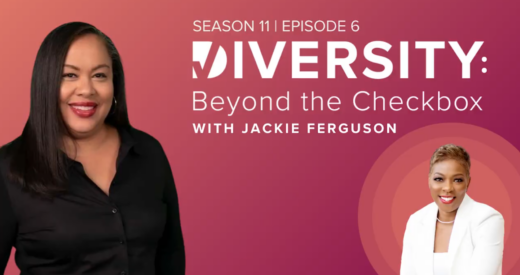It wasn’t until I was co-organizing a panel discussion for Women’s Heritage Month that it occurred to me. I’ve been an ally to so many underrepresented communities, groups, and markets in the U.S. and have been working on marketing campaigns to uplift the voices of each of these communities but never really thought of empowering my own: the beautifully complex, versatile, and fluid experience of Arab individuals in the United States.
Let’s be honest. Arab individuals have been – and are still being – underrepresented and misrepresented in the media and in U.S. workplaces. Of course, Arab Americans are not the only demographic group that is under- and misrepresented, but it still feels true to say we rarely receive much attention or appreciation in today’s organization-wide diversity, equity, and inclusion (DEI) programs. That’s one of the reasons I believe it is essential for HR leaders, CEOs, DEI practitioners, and more to understand, acknowledge, and engage in National Arab American History Month (NAAHM), which takes place every April.
“Defining who is Arab is a work in progress”
In 2022, the total Arab American population is estimated to be around 3.6 million people, although the U.S. census most likely undercounts the number of people in America who are of Arab descent, ancestry, or heritage, according to Maya Berry, Executive Director of the Arab American Institute in Washington, D.C.
As NPR reports, undercounting could be caused by many factors, including the placement of the ancestry question on census documents and “distrust/misunderstanding of government surveys among recent immigrants. […] The current census definition of ‘Arab ancestry’ also excludes Arab League countries such as Somalia and Sudan as countries of origin,” they point out. “Census Bureau officials say defining who is Arab is a work in progress.”
Understanding the Arab American Experience (Briefly)
What is the definition of an Arab person? Put briefly, someone may identify as Arab if their heritage connects to any Arabic-speaking country or culture. “Arab” refers to culture and background, and “Arabic” refers to language. There are 22 Arabic-speaking countries in the world – including Lebanon, Algeria, Palestine, Syria, Morocco, Egypt, and more. Arabic is one of the fastest-growing languages in the United States and currently the fifth most-spoken language in the world
Although many people associate Arab communities with the religion of Islam, Arabic-speaking countries contain many different religions, including Christianity, Hinduism, and Judaism. They also include many different ethnicities, customs, dialects and accents, traditions, and more.
Not all Arab people are Muslim, and not all Muslim people are of Arab heritage.
It’s also important to understand that Arab individuals come from various races and have various skin tones, whether Black, White, brown-skinned, olive-skinned, or more. Also, people of Arab descent come from almost everywhere in the world: North Africa, the Middle East, Western Asian, and more. Yes! A North African person is also considered Arab. And yes, there are many Middle Eastern people who are not necessarily Arab because Arabic is not their primary language. Examples include people from Turkey, Iran, and Iraq.
The main intersectional experience among Arab people from these 22 countries is the Arabic language and certain cultural nuances. For instance, imagine a person named Sherif, a 20-something, Muslim, Algerian male who identifies as Afro-Arab. He is standing at a coffee shop in New York City, talking with Jawad, a 50-something, Christian, Lebanese man with light skin who does not identify with color or race. They both communicate in Arabic and French (given the colonization of both their countries by France) and are sharing with each other how their parents cooked similar recipes when they were children. Yet they both acknowledge that their religion, ethnicity, certain cultural customs, the geographical location of their hometowns, social norms, and views are different. What brings them together is how they both value their common experiences as Arab people and Arab Americans.
As a side note, when I say that Jawad does not identify with color or race, what I mean is that his skin tone is not an important part of his identity for him. Most Arab countries – similar to many Caribbean, African, and Latine communities – do not have the notion of “people of color,” and when individuals from these countries migrate to the U.S., they typically do not identify with that term. Instead, they stay true to their own identification of their race and ethnicity. Usually, they will tell you they are “Lebanese American” or “Syrian American,” just as many people of Latin American heritage will not identify with the terms Latine or Latinx and, instead, will say “I am Colombian American” or “I am Cuban American.”
Celebrating National Arab American Heritage Month (NAAHM)
Although Arab people in the United States celebrate their cultures sporadically throughout the year, until 2019, there was no officially-recognized day, week, or month to highlight the presence and achievements of Arab communities in America. That year, Representatives Debbie Dingell and Rashida Tlaib issued a congressional resolution for NAAHM to be recognized on a national scale. Some individual states (in fact, 26 of them) moved forward to proclaim April as Arab American Heritage Month, but it wasn’t until 2021 that the first recognition on a federal level was issued and published as a White House Letter from President Biden.
National Arab American Heritage Month now offers a focal point for street festivals, seminars, workshops, restaurant weeks, industry events, and award ceremonies celebrating Arab excellency in multiple fields of work. One notable event is the National Arab American Heritage Month Commemoration, which takes place in late April in Washington D.C. each year. Hosted by the Arab America Foundation, “the event is attended by members of Congress, state and local leaders, and members of the Arab American community.” It is a night to shine a spotlight on Arab heritage,culture, arts, music, dance, and food.
In 2022, April also happens to align with Ramadan, the ninth and holiest month of the Islamic calendar. Learn more about diverse holidays throughout the year by downloading and subscribing to The Diversity Movement’s 2022 Diversity Holidays Calendar.
A Few Notable Professionals of Arab Background
From politics to business, arts, and education, Arab Americans have shown excellence within their fields while taking pride in their cultural backgrounds. Here, we’ll highlight just a few who are moving the needle in the U.S., such as Representative Rashida Tlaib. Representative Tlaib is of Palestinian background and is a highly influential figure on the national stage, especially as an inspiration to young Arab women and those who are in or are migrating from Palestine to the U.S.
Albert Baladi, the notable Lebanese CEO of Beam Suntory, is a shining example of the Lebanese Diapsora’s linguistic excellence (he speaks four languages) and of business success.
And also Layla F. Saad, an accomplished New York Times Best-Selling Author of East African and Arab descent who identifies as Black and Muslim, has contributed powerful work in education and on topics such as race, identity, and social change.
What can you do to honor NAAHM at your organization?
Below are simple starter steps you can address:
1. Respecting Cultural Practices (e.g. Ramadan)
The most crucial step in understanding an employee’s lived experience is to follow the DAJA approach. Take a moment to ask and learn about your Arab-identifying employee’s culture and inquire about their cultural practices (specifically if they are Muslim and celebrate Ramadan). Remember that there are distinct cultural and religious practices that differ between Christian Muslims and Arab Muslims.
When it comes to a holiday like Ramadan, it is best to approach your colleague at least a week or two ahead of the start of the holiday and ask about any schedule changes or accommodations they will need, what the company can provide, and if they need any support. At the end of the day, you want your employees to know they are part of a healthy and safe environment, so remember not to impose or force any rules or unnecessary regulations, and allow them to have a schedule and a work environment that caters to their cultural and religious practices during this month.
“My biggest advice to DEI practitioners is to ask their employees what accommodations their employees need for holidays around the year. Ramadan is around the corner, and it is the longest celebrated holiday in the world. Companies should be aware that Muslims practice in different ways, and there is no one-size fits all accomodation, as we come from a vast variety of cultures, personalities, and ways of practicing. You may find that someone would prefer to have a flexible schedule where they can start their day later due to their sleeping schedule shifting for late-night worship and their pre-dawn breakfast, while another may prefer to start their day earlier to get their work done while they feel most fueled and energetic. While many people like myself insist to have a seat at the table, it is too often that Muslim employees, which are often discriminated against, keep to themselves and find ways to make due in very inconvenient ways.” – Usra Atalla. Graphic Designer, meQuilibrium
2. Providing Space for Cultural Celebration
Similar to many other communities – especially immigrant and expatriate groups – many Arab American people find happiness in celebrating their culture with friends who are from different backgrounds. Take the opportunity during this month to empower your employees’ celebration of their culture. Acknowledge National Arab American Heritage Month in your internal and external communications and include a way for Arab American employees to give feedback about how they would like to be acknowledged and celebrated. To avoid performative allyship and tokenization, include the people you are trying to celebrate in the planning process and make it clear to your entire workforce that learning about underrepresented cultures benefits the entire organization.
Also, provide the opportunity for your Arab-identifying colleagues to take the lead on initiating events, lectures, workshops, and/or cultural-learning activities that they are comfortable with, and provide proper resources for these events. Your celebration of National Arab American Heritage Month can be as simple as an introductory workshop on Arabic 101, a brief history of the Arab diaspora, or a potluck lunch that provides an introduction to meals from the Arab continent and a chance to share personal stories of cultural upbringing and integration into the American space.
“Sometimes, agencies want our Arab names to polish their reputation of being diverse but they don’t want our Arab experiences. Agency leadership needs to understand that we’re not a monolithic group. They need to give us a space where we can be our true selves, unfiltered. For years, the American system erased MENA [Middle East and North African] experiences by folding millions of people into the “White” race/ethnicity category.
Agencies can help change that by seeing their Arab employees and giving them opportunities to showcase their cultures at work and in their work. This is especially true for global agencies. Gone are the days when your Arab employees are just here to translate your lines to Arabic. Get us involved early. We know our stuff and can make your stuff better.” – Chamsseddine Abdelhafidh, Associate Creative Director, R/GA.
“One way for companies to empower Arab American groups is to learn how to navigate these conversations and lend a supporting hand when our home countries are affected by war, similar to what is being done now in Ukraine. At my last company, when homes were being raided in Palestine, a few coworkers reached out to check in on me; however, none of the higher-ups brought attention to what was happening or sent out a company email like they do with other issues. This simple gesture would’ve made me feel included and comforted, instead of hidden away. Another way to empower Arab Americans is to create spaces where peers can share their culture and foods, educate other coworkers on what is and isn’t appropriate to say, and be open to differing opinions”. – Shahed Khaddaj, Producer/Director, HearstMade
National Arab American Heritage Month is an ideal time to empower the Arab American experience in your company and in your DEI efforts. Start by reaching out to your employees and giving them space to take lead in sharing their narratives.
Jad Evangelo-Nasser is a multilingual Media & Communications professional and educator with global experience in creative agencies in the Middle East, North African and North American regions with extensive skill sets in film production, creative marketing strategies, DEI, and learning and development.






